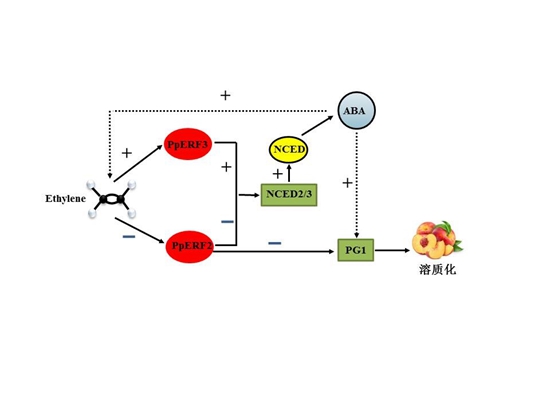The Mechanism of Peach Ethylene Response Factor (ERFs) Regulating Fruit Abscisic Acid Biosynthesis
Source: Zhengzhou Fruit Research Institute
The research team led by Professor Wang Zhiqiang from the Zhengzhou Fruit Research Institute of Chinese Academy of Agricultural Sciences (CAAS) has been working on the study of peach fruit quality biology for many years. Recently, the team made important progress in the molecular mechanism of ethylene and abscisic acid synergistically regulating fruit ripening and softening.
Peach cultivars are classified as melting flesh (MF) or non-melting flesh based on their fruit firmness and texture. Generally speaking, ethylene is essential for the ripening of climacteric fruits; and abscisic acid (ABA) played an important role in non-climacteric fruits ripening process. Peach are climacteric fruits and experience a remarkable increase in ethylene production during fruit ripening process, and rapid softening occurs after harvest. Most study revealed that ABA levels sharply increase preceding the release of ethylene, so it is believed that there is a sharp increase in ABA accumulation during the onset of fruit ripening and/or the ripening process. This study found that both ethylene and ABA has a release peak in the late ripening stage of peach fruit. Exploring the relationship between ethylene and ABA in the late ripening stage will provide insight into the regulatory network linking ethylene and ABA signaling.

Regulatory network between ethylene and abscisic acid
Based on transcriptome and qRT-PCR analysis of all Ethylene Responsive Factor (AP2/ERF) genes in peach, AP2/ERF genes with significant different expression levels in CN16 (stony hard) peaches and CN13 (melting flesh) peaches during fruit maturation was identified. Prupe.5G090800 (PpERF2) shared a opposite trend expression profile with that of PpNCED2、PpNCED3 and PpPG1; while the expression profile of Prupe7G.194400 (PpERF3) was similar with that of PpNCED2、PpNCED3. The expression of these genes was inhibited by 1-MCP treatment in ‘CN13’ and ABA biosynthesis was also inhibited; Online tool PlantCARE database (http://bioinformatics.psb.ugent.be/webtools/plantcare/html/) analysis found ERF-binding motifs (CCGAC 、 A/GCCGAC 、 AA/TTTCAAA) in PpNCED2, PpNCED3 and PpPG1 promoter; PpNCED2/3-pro::GUS vector was constructed and transiently expressed these genes in tomato fruits at breaker stage; As expected, GUS driven by the PpNCED2/3 promoter was highly expressed in fruits treated with ethylene and not strongly expressed in untreated fruits; Then YIH, electrophoretic mobility shift assay (EMSA), dual-luciferase reporter assay (DLR), transient expression in peach fruit demonstrated that 1) PpERF2 was a repressor and could directly bind to the PpNCED2, PpNCED3, PpPG1 promotors through CCGAC motif and repressed the promoter activities; 2) PpERF3 affected ABA biosynthesis by binding to the promoters of PpNCED2, PpNCED3 and increased the expression of PpNCED2, PpNCED3. These results first revealed that ethylene could regulate the synthesis of abscisic acid by regulating the expression of abscisic acid synthesis gene PpNCED via PpERFs.
The study was published in Horticulture Research and Plant Science. This work was supported by the National Natural Science Foundation of China [No. 31501732 and No. 31872085], the National Key Research and Development Program [2018YFD1000200], the Agricultural Science and Technology Innovation Program (ASTIP) [CAAS-ASTIP-2018-ZFRI]. More details can be found in the link:
https://www.sciencedirect.com/science/article/pii/S0168945218310124
https://www.nature.com/articles/s41438-018-0094-2
By Zeng Wenfang(zengwenfang@caas.cn)



